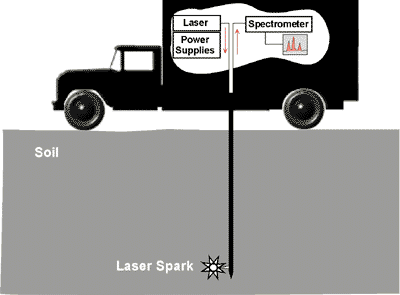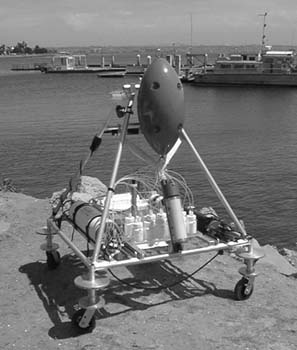|
November 2000 Fiber Optic/Cone Penetrometer System Used for Heavy Metal Detectionby Karen Cohen, U.S. Department of Energy/National Energy Technology Laboratory, and Steven Saggese, Ph.D., Science and Engineering Associates, Inc. The U.S. Department of Energy (DOE) National Energy Technology Laboratory (NETL) has developed an integrated laser-induced breakdown spectroscopy (LIBS) and cone penetrometer technology (CPT) system to analyze the heavy-metals content of subsurface soils. A recent demonstration to detect chromium at DOE’s Chemical Waste Landfill at Sandia National Labs (SNL) near Albuquerque, NM, showed that this in situ LIBS/CPT system successfully produced analytical results within 24 hours. In addition to allowing for rapid, in situ analysis, the LIBS/CPT system offers the advantages of providing continuous measurements, minimal site intrusion and waste generation, and reduced field worker exposure to hazardous samples. The CPT-deployed, LIBS-based system (Figure 1) utilizes a high energy laser pulse that is delivered into soil by a Nd:YAG (neodynium:yttrium aluminum garnet) laser operating at 1.06 µm. By absorbing laser energy, the soil heats rapidly to an electronically excited plasma. When the excitation energy is removed, excited electrons drop to lower energy levels and emit characteristic photons. The plasma emission spectrum from the sample is observed through an optical fiber. Elemental analysis then is conducted with an on-site computer by observing the wavelength and intensities of the emission lines, which vary with the type and amount of material present within the plasma.
During the three-day SNL field test, six penetrations were conducted to a depth of 15 feet. The resulting data were used to generate detailed graphics depicting the chromium concentration as a function of depth, with a range of chromium concentrations from 30 parts per million (background) to 1,200 parts per million. These results correlated highly with data collected from past soil borings installed in the test location. Costs for deploying the LIBS/CPT system at SNL were estimated to total $4,116 per 30 feet of soil penetration, including expenses for the LIBS system, set-up, and operation; field mobilization and demobilization; CPT rig equipment and labor; and equipment calibration. This represents a 31 percent cost savings when compared to conventional site characterization methods involving subsurface drilling, collection of core samples, and off-site laboratory analysis. The LIBS system also can be deployed in a stand-alone system, without the CPT but with a back-pack or cart-mounted system, to analyze surficial soil samples or grab samples. Full-scale application of the stand-alone method was conducted successfully for beryllium detection at a former military site near Luckey, OH. For more information, contact Karen Cohen (NETL) at 412-386-6667 or cohen@netl.doe.gov, or Dr. Steven Saggese (Science and Engineering Associates, Inc.) at 505-346-9862 or e-mail sjsaggese@seabase.com. ETV Verifications Conducted on Analytical Technologies for PCBsby Amy Dindal, U.S. Department of Energy/Oak Ridge National Laboratory, and Eric Koglin, U.S. EPA/National Exposure Research Laboratory Performance verifications for eight field analytical techniques capable of detecting and quantifying polychlorinated biphenyls (PCBs) in soils and solvent extracts have been conducted since 1997 under the U.S. EPA’s Environmental Technology Verification (ETV) Program. In 2000, the performance of one technology (L2000DX Analyzer) was verified for its ability to detect PCBs in transformer oil. As part of the ETV’s Site Characterization and Monitoring Technologies Pilot Program, these verification tests were designed to obtain technology performance information by using environmental and quality control samples. The data generated by the field techniques were compared to the data produced by a conventional laboratory using standard methods. Final results for seven of these technology verifications now are available on the web. Six of the PCB performance verifications involved immunoassay test kits:
Other technologies for which verification reports are complete include the 4100 Vapor Detector (Electronic Sensor Technology), which is a gas chromatograph with a surface acoustic wave detector, and the L2000 PCB/Chloride Analyzer (Dexsil Corporation), an ion-specific electrode instrument. Performance results for the L2000DX Analyzer, an updated instrument from the one verified in 1997, and the DELFIA PCB Assay will be available in early 2001. Each technology’s performance was evaluated under two distinct environmental conditions: (1) a controlled chamber with constant temperature and relative humidity, and (2) outdoors, under naturally variable temperature and relative humidity. PCB concentrations ranged from 0 to 700 parts per million (ppm) in soil samples and 0 to 100 µg/mL in extract (simulated wipe) samples. Vendors used their technologies to analyze 116 samples in each of the two test conditions, which involved a total of 72 performance evaluation soil, 136 environmental soil, and 24 extract (simulated wipe) samples. For the PCB-in-oil verification analyses, a total of 152 samples, ranging in PCB concentration from 0 to 300 ppm, were analyzed. Performance of the PCB technologies was judged based on commonly used measures of method performance: precision, accuracy, comparability, detection limits (when appropriate), sample throughput rate, false positive rate, and false negative rate. The range of performance for selected factors for quantitative PCB technologies is presented in Figure 2. Depending on the technology, sample throughput ranged from 5 to 18 samples per hour. Figure 2. Performance Range for PCB Analyzers
Verification reports containing detailed information on these and other performance factors, such as cost and regulatory applicability, are available on-line from Oak Ridge National Laboratory at www.ornl.gov/etv and on the ETV web site at www.epa.gov/etv. Additional information may be obtained from Amy Dindal (ORNL) at 865-574-4863 or e-mail dindalab@ornl.gov, or Eric Koglin (National Exposure Research Laboratory) at 702-798-2432 or e-mail koglin.eric@epa.gov. Flux Measurement Used to Characterize Sediment Contamination Mobilityby Thomas W. Hampton, Space and Naval Warfare Systems Center, San Diego Through its Environmental Sciences Division, the U.S. Navy’s Space and Naval Warfare Systems Center, San Diego, (SSC SD) has developed a unique instrument for obtaining in situ, direct measurement of contaminant fluxes from marine sediments. The Benthic Flux Sampling Device 2 (BFSD2), is a flux chamber that isolates a volume of seawater over sediments to quantify contaminant flux, thereby allowing for assessment of contaminant mobility across a sediment-water interface. BFSD2 was used to characterize metal contaminants in sediments at the Naval Station San Diego (Paleta Creek site) and Alameda Naval Air Station (Seaplane Lagoon site) in California, as well as the Pearl Harbor Naval Complex (Bishop Point and Middle Loch sites) in Hawaii. Results showed that BFSD2 provided a reliable means for evaluating the mobility, source loading to water column, and potential bioavailability of in-place sediment contamination. The commercially-available BFSD2 is adapted from benthic flux chamber technology developed in oceanography for studying the cycles of major elements and nutrients on the seafloor. A flux out of or into the sediment is measured by isolating a volume of water above the sediment, drawing off samples from the volume over time, and analyzing the samples for increase or decrease in toxicant concentration. Increasing concentrations indicate that the toxicant is fluxing out of the sediment, while decreasing concentrations indicate that the toxicant is fluxing into the sediment. BFSD2 instrumentation consists of a pyramid-shaped tubular frame, an open-bottomed chamber, and associated sampling and control equipment (Figure 3). At the top of the frame is an acoustically released buoy for instrumentation recovery. At the bottom of the frame are the open-bottomed chamber and associated sampling gear, flow-through sensors, data acquisition and control unit, video camera system, power supply, and oxygen supply system.
As a sample collection technology, the BFSD2 uses established methods, standard operating procedures, laboratory quality assurance and control procedures, and data validation processes. Internal quality assurance checks typically include silica flux, oxygen and pH stability, and statistical tests. Advantages of the BFSD include the capability to:
The BFSD2 provides a unique means of evaluating the significance of in-place sediment contamination. Presently, there is no other viable method for direct quantification of sediments as sources. At sites where it can be demonstrated that remobilization of contaminants is limited, significant cost savings may be achieved through reduction of cleanup costs. Estimated disposal costs for contaminated sediment range from $100 to $1000 per cubic yard. SSC SD researchers anticipate near-future extension of this technology to quantify mobility of organic contaminants such as polyaromatic hydrocarbons, polychlorinated biphenyls, and pesticides in marine sediments. For additional information, contact Tom Hampton (SSC SD) at 619-553-1172 or e-mail thampton@spawar.navy.mil, or Dr. Bart Chadwick (SSC SD) at 619-553-5333 or e-mail chadwick@spawar.navy.mil. Brownfields Technology Support Center Now OpenThe U.S. EPA’s Technology Innovation Office has opened a technical support center to assist brownfields decision-makers in understanding the full range of available technologies and in making informed technology decisions. Through this center, combined resources from the Office of Research and Development’s National Risk Management Research Laboratories and the National Exposure Research Laboratory provide support to localities, states, and federal brownfields staff. The Center can help localities:
Requests for assistance may be submitted on-line at www.brownfieldstsc.org, or through the Brownfields Technology Center Hotline at 877-838-7220. New Web Site Developed to Exchange Information on Sensor TechnologiesThe Sensor Technology Information Exchange (SenTIX) is available to improve communication among sensor developers, vendors, and users inside and outside of the environmental arena. Developed by WPI (a not-for-profit corporation affiliated with Virginia Polytechnic Institute and State University) through a cooperative agreement with the U.S. EPA, SenTIX serves as a diverse forum for exchanging information on sensor technologies and needs. The SenTIX database contains functions that play match-maker between users looking for sensor technologies to meet specific needs, and developers having commercially-available (or potential) sensors that could meet those needs. SenTIX also provides a vehicle for discussions on technology needs and developments, and for posting information on upcoming events and news topics. SenTIX is available at www.sentix.org. To obtain additional information, contact Larry Keith (WPI) at Larry_Keith@wpi.org or 678-344-0001.
|
|||||||||||||||||||||||
|
|||||||||||||||||||||||









